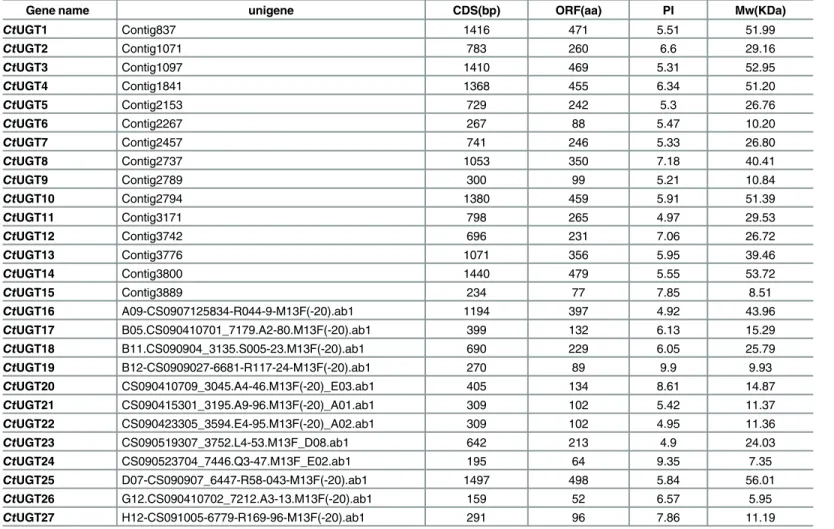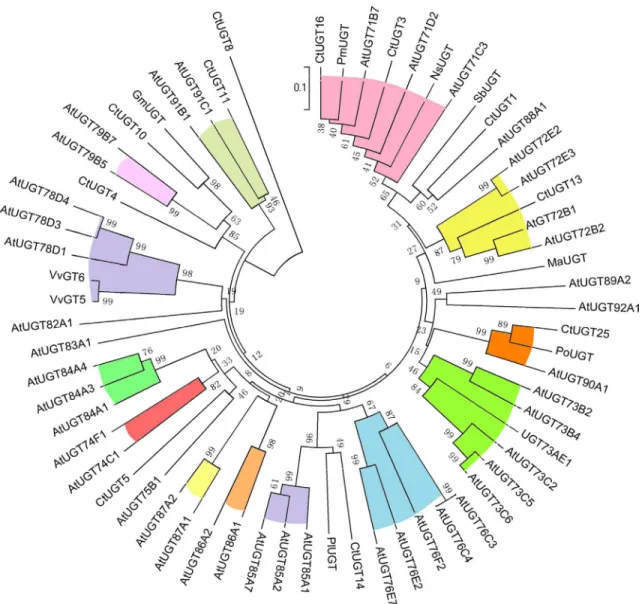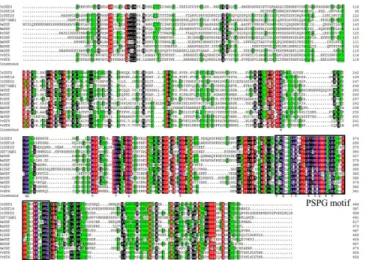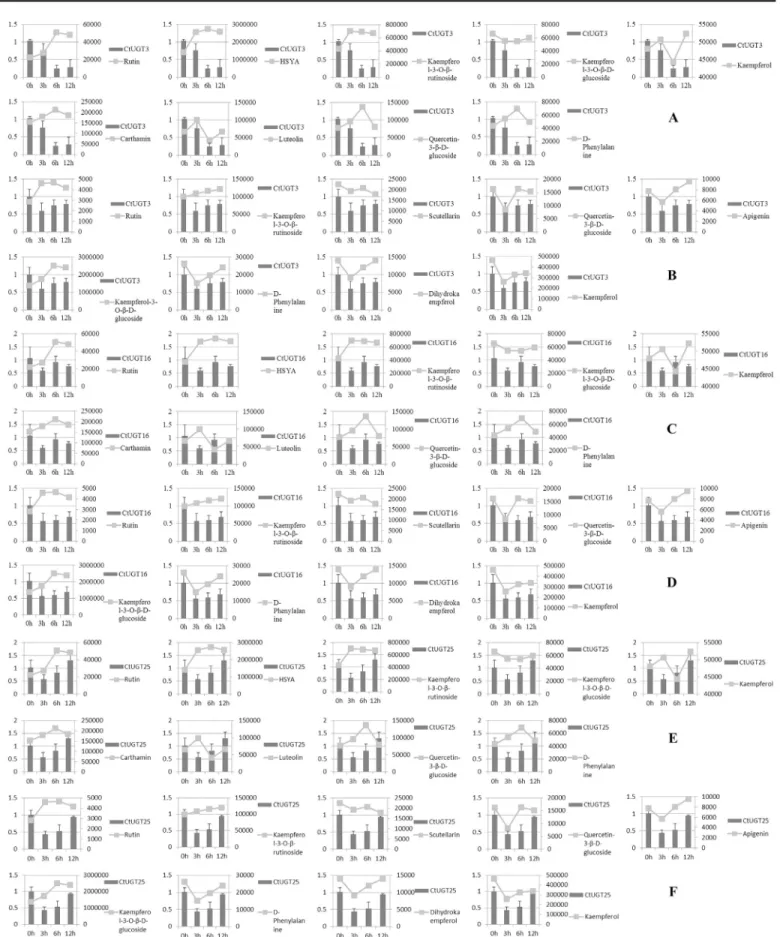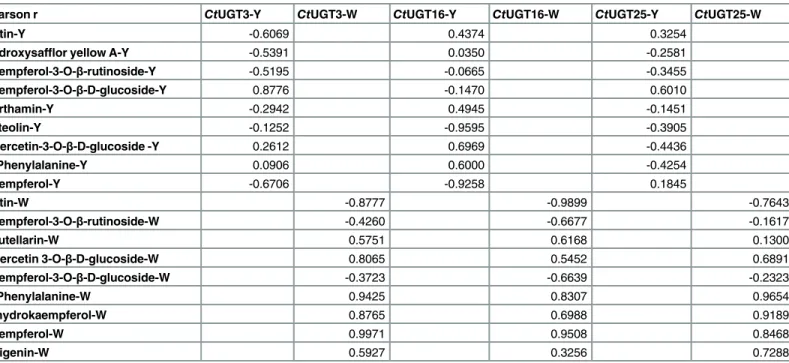Expression Patterns of Three UGT Genes in
Different Chemotype Safflower Lines and
under MeJA Stimulus Revealed Their
Potential Role in Flavonoid Biosynthesis
Dan-Dan Guo, Fei Liu, Yan-Hua Tu, Bei-Xuan He, Yue Gao*, Mei-Li Guo*
Department of Pharmacognosy, College of Pharmacy, Second Military Medical University, 200433, Shanghai, China
*mlguo@126.com(MLG);gaoyue2000@hotmail.com(YG)
Abstract
Safflower (Carthamus tinctoriusL.) has received a significant amount of attention as a medici-nal plant in China. Flavonoids are the dominant active medical compounds. UDP-glycosyl-transferase plays an essential role in the biosynthesis and storage of flavonoids in safflower. In this study, 45 UGT unigenes were screened from our transcriptomic database of safflower. Among them, 27 UGT unigenes were predicted to own a complete open reading frame with various pI and Mw. The phylogenetic tree showed thatCtUGT3 andCtUGT16 were classified under the UGT71 subfamily involved in metabolite process, whereasCtUGT25 has high iden-tities withPoUGT both catalyzing the glycosylation of flavonoids and belonging to the UGT90 subfamily. cDNA microarray exhibited that the three UGT genes displayed temporal difference in two chemotype safflower lines. To functionally characterize UGT in safflower,CtUGT3, CtUGT16 andCtUGT25 were cloned and analyzed. Subcellular localization suggested that the three UGTs might be located in the cell cytoplasm and chloroplast. The expression pattern showed that the three UGTs were all suppressed in two lines responsive to methyl jasmonate induction. The co-expression relation of expression pattern and metabolite accumulation dem-onstrated thatCtUGT3 andCtUGT25 were positively related to kaempferol-3-O-β-D-glucoside andCtUGT16 was positively related to quercetin-3-O-β-D-glucoside in yellow line, whereas CtUGT3 andCtUGT25 were positively related to quercetin-3-O-β-D-glucoside in white line. This study indicates that the threeCtUGTs play a significant and multiple role in flavonoids bio-synthesis with presenting different functional characterization in two safflower lines.
Introduction
Safflower (Carthamus tinctoriusL.) is cultivated mainly for medicinal use, with its dried tubu-lar flowers being the medicinal part and its seeds being commonly consumed as vegetable oil in many countries due to their abundant unsaturated fatty acid, oleic acid andα-linoleic acid [1]. Flavonoid compounds, quinochalcone glycosides [hydrosafflower yellow A (HSYA), cartha-min, tinctorimine, cartorimin]. and flavonol glycosides (kaempferol glucosides and quercetin
a11111
OPEN ACCESS
Citation:Guo D-D, Liu F, Tu Y-H, He B-X, Gao Y, Guo M-L (2016) Expression Patterns of Three UGT Genes in Different Chemotype Safflower Lines and under MeJA Stimulus Revealed Their Potential Role in Flavonoid Biosynthesis. PLoS ONE 11(7): e0158159. doi:10.1371/journal.pone.0158159
Editor:Yuepeng Han, Wuhan Botanical Garden of Chinese Academy of Sciences, CHINA
Received:January 28, 2016
Accepted:June 10, 2016
Published:July 8, 2016
Copyright:© 2016 Guo et al. This is an open access article distributed under the terms of theCreative Commons Attribution License, which permits unrestricted use, distribution, and reproduction in any medium, provided the original author and source are credited.
Data Availability Statement:All relevant data are within the paper and its Supporting Information files.
Funding:This work was supported by a grant from Natural Science Foundation of China (81173484 and 81473300), Shanghai Natural Science Foundation (13ZR1448200) and“863”High Technology Project (2008AA02Z137).
glucosides) are considered as the characteristic and active constituents in safflower [2] and pose a wide spectrum of biological and pharmacological effects, such as cerebrovascular and cardiovascular protective activities [3–5].
With the boom of the large-scale transcriptomic analysis, various deep sequencing tech-niques were employed in plants, such as inLonicera japonica Thunb. [6],Lilium regale[7] and
Panax ginseng[8]. The transcriptome of safflower was obtained to explore the gene family involved in the biosynthesis of flavonoids, such as phenylalanine ammonia-lyase (PAL), cinna-mate-4-hydroxylase (C4H), chalcone synthase (CHS), chalcone isomerase (CHI), flavonone 3-hydroxylase (F3H) and flavonoid UDP-glycosyltransferase (UGT).
Many researches have demonstrated that UGT plays an essential role in the biosynthesis of secondary metabolites in plants [9]. UGT transfers nucleotide- diphosphate-activated sugars to low molecular weight (Mw) substrates. Intrinsic sugar donor in plants contains UDP-glucose, UDP-galactose, UDP-rhamnose, and UDP-glucuronic acid [10]. Sugar moieties, as part of many bioactive natural products, have significant effects on the physiological activity, selectivity, and other pharmacological properties [11,12]. The UGT family belongs to group 1 of a larger family of glycosyltransferases that have a similar protein structure (GT-B Rossmann-fold) [10]. The present UGT homepage ( http:www.flinders.edu.au/medi-cine/sites/clinical-pharmacology/ugt-homepage.cfm) consists of a large list of UGT families, subfamilies and hundreds of approved UGTs, where families 71 to 100 are for plants [13]. The UGT superfamily is characterized by a common protein structure and a well-conserved sequence of 44 amino acids (called a PSPG box) responsible for binding the UDP moiety of the sugar donor [14–16]. Glycosylation is a promi-nent modification reaction [17]; therefore, the glycosylation process of flavonoids in safflower is important to biosynthesize the important active flavonoid compounds.
In the past few years, studies on plant glycosyltransferase have revealed that dramatically varied glycosyltransferases are involved in plant secondary metabolism [16,18], such as Arabi-dopsis thaliana,cereals,Catharanthus roseus,rice,Crocus sativus,and Litchi chinensis[19–26]. However, as an important medicinal plant with glycosylated flavonoids [27,28], the glycosyla-tion process is largely unknown and rarely reported. Only one UGT (UGT73AE1) has been explored, but there is no biological view to explain the link between the gene and metabolic pathway evolution [29]. Here, we report the characterization of three UGTs through their in vitro and in vivo expression as well as their metabolite analysis response to methyl jasmonate (MeJA). These findings partly demonstrate the potential functionality of UGTs in the glycosyl-ation of the flavonoids metabolism pathway in safflower.
Materials and Methods
Plant materials
Two lines of safflower (ZHH0119 with yellow flower line and XHH007 with white flower line;
Fig 1) were grown in the greenhouse of the Second Military Medical University (Shanghai City, China). The ZHH0119 line, which has orange-yellow floret, is a major source of quinochal-cones and flavonols, whereas the XHH007 line with white floret, mainly contains flavonols without quinochalcones. The plants were cultivated at a mean temperature of 25°C with circa-dian rhythm of 16 h-light/8 h-darkness.
Transcriptome data analysis and multiple sequence alignment of
Ct
UGT
genes
safflower transcriptome sequencing was performed to find more genes involved in the biosyn-thetic pathway of active components. Gene annotations were predicted by BLASTx and BLASTn search homologs in the Nr and Nt database. UGTs were selected from annotated genes. The open reading frame (ORF) prediction was carried out and amino acids were deduced in ORF Finder. The theoretical isoelectric point (pI) and Mw were predicted using the Compute pI/Mw tool on the ExPASy server (http://web.expasy.org/compute_pi/). The multiple sequence alignment of the UGTs was performed using ClustalX version 2.0 [30]. Phylogenetic trees were constructed using MEGA 5.0 with the neighbor-joining method. Bootstrap test was replicated 1000 times [31].
Agilent cDNA expression profile microarray
Using cDNA expression profile microarray, many differently expressed genes were identified. Signal values were normalized with log2. Hot map for expression signal intensity and hierar-chical clustering (HCL) were conducted by MeV [32], whereas stage I of the two lines was treated as the control group. All samples with three biological repeats were carried out.
Cloning of CtUGT full-length cDNA
Total RNA was isolated with the RNeasy Plant Mini Kit (Qiagen, Germany) according to the manufacturer’s protocol. The 30- and 50- cDNA libraries of safflower were constructed using
the Clontech SmartTMRapid Amplification of cDNA Ends (RACE) cDNA amplification kit (Clontech, USA). Then, RACE was carried out. Based on the sequences of the 30- and 50-RACE
products, the primer were designed to clone the full length of genes. Polymerase chain reaction (PCR) was performed using cDNA (TransScript1One-Step gDNA Removal and cDNA Syn-thesis Super Mix; TransGen Biotech, Beijing, China) as a template and with KOD-Plus-Neo polymerase (Toyobo, Japan) under the following conditions: 30 cycles of 10 s denaturation at 94°C, 30 s annealing at 58°C, and 1 min amplification at 72°C. The PCR products were gel-purified (QIAquick1Gel Extraction Kit; Qiagen) and cloned into the PMD19T vector (TaKaRa, Japan). Using blue-white spot screening, the recombinant plasmids were recovered fromEscherichia coliDH5αcells using QIAquick1Spin Plasmid Mini-prep kit (Qiagen) and both strands were sequenced (MeiJi, China).
Bioinformatics of three
Ct
UGTs
The obtained full-length cDNA sequence and deduced protein were analyzed using the follow-ing websites:www.ncbi.nlm.nih.govandwww.expasy.org. The tertiary structure ofCtUGT3,
CtUGT16, andCtUGT25 was predicted onwww.swissmodel.expasy.org. Protein subcellular
Fig 1. Two lines of safflower.(A) yellow flower line. (B) white flower line.
localization was predicted in WoLF PSORT (advanced computational tool for protein subcellu-lar location prediction).
Induction and quantitative real-time PCR of MeJA-treated safflower
petals
MeJA (100μM; Sigma, USA) solution was sprayed onto petals of safflower that opened on the
first day. The petals were then enclosed in plastic bags. In the control group, the petals were sprayed with the same solution but without MeJA and then covered with plastic bags. After 0, 3, 6, and 12 h of treatment, the plastic bags were removed, and at least three samples of flowers at four time points were collected; these samples were frozen immediately in liquid nitrogen and stored in freezers at -80°C.
cDNAs were synthesized with 1μg RNA according to the manufacturer’s instructions of
TransScript1One-Step gDNA Removal and cDNA Synthesis SuperMix (TransGen Biotech). Q-PCR [33] was performed according to the instructions of the SYBR Green Realtime Master Mix kit (Toyobo) with the ABI 7500 system (ABI, USA). The specific primers used for quantifi-cation were designed using Primer 5. PCR conditions comprised an initial holding at 95°C for 3min. the cycle stage of the PCR program consists of 95°C for 10 s and 58°C for 20 s and 72°C for 35 s for 40 cycles. Standard deviations were calculated from three PCR replicates. The speci-ficity of amplification was assessed by dissociation curve analysis, and the relative abundance of genes was determined using the comparative Ct method and normalized by that for 60S.
Metabolite analysis of MeJA treated by UPLC-QTOF/MS
Safflower petal samples were dried at 50°C to constant weight and ground into powder. Subse-quently, an aliquot of 10 mg samples was soaked overnight and extracted for 40 min sonication with 60% methanol under sealed conditions. Then, the extract was filtered through a 0.20μm
microporous membrane for analysis. The metabolites were identified using Agilent Technolo-gies 6538 UHD Accurate Mass Q-TOF LC/MS (Agilent TechnoloTechnolo-gies 1290 Infinity). Waters XSELECT HSS T3 (100×2.1 mm, 2.5μm); mobile phase A, 0.1% methanoic acid; mobile phase
B, acetonitrile with 0.1 formic acid; flow rate, 0.4 ml/min; column temperature, 40°C; gradient elution; 0-2min, A:B = 95:5, 2–4 min, A:B = 80:20, 4–6 min, A:B = 79:21, 6–9 min, A:B = 74:26, 9–11 min, A:B = 60:40, 11–15 min, A:B = 20:80, 15–17 min, A:B = 5:95, and 17–19 min, A: B = 5:95; injection volume: 4μl.
Mass spectrometer was performed and positive ion mode was used for the quantification. Mass acquisition range: 100–1000; gas temperature, 350°C; gas flow, 11 L/min; nebulizer, 45 psi; Vcap, 4000V; fragmentor, 120V; skimmer, 60v; octopoleRFPeaK, 750v; reference masses, m/z 121.0509 and 922.0098. 17 compounds were dealed with target compound and analyzed. 12 standard chemical compounds were purchased from Sigma-Aldrich (St. Louis, MO).
Results
Transcriptome data analysis, multiple sequence alignment, and
phylogenetic analysis
Their pI is from 5.5 to 7.5, but Mw varies greatly. 27CtUGT genes were translated into proteins inS2 Table. Based onCtUGTs,AtUGTs and UGTs from other plant species (Fig 2), the phylo-genetic tree was constructed. Our results showed thatCtUGT3 andCtUGT16 were classified under the UGT71 subfamily involved in metabolite process, whereasCtUGT25 has high identi-ties withPoUGT (GenBank accession number ACB56926.1 fromPilosella officinarum) both catalyzing the glycosylation of flavonoids and belonging to the UGT90 subfamily. Given the high identities of the reported flavonoid GTs (Fig 3) in multiple sequence alignment, three
CtUGT genes can be tentatively assigned as a flavonoid glycosyltransferase inC.tinctorius. Therefore, to functionally characterize UGT in safflower,CtUGT3,CtUGT16, andCtUGT25 were cloned and analyzed.
cDNA microarray expression analysis
From microarray data, differential genes were determined (p0.05) by comparing two groups in yellow and white lines respectively. Because flags were 3A (not obvious between signal and background) found in microarray data, two UGTs (UGT17 and UGT22) were removed. Hot map revealed that 25 UGTs have different expression at different stages of yellow and white lines. The colour key is from -0.5 to 0.5. Obviously, the expression values of all 25 UGTs pres-ent differpres-ent expression models at differpres-ent developmpres-ental stages of yellow and white line
Table 1. Identification of UGT genes in safflower by transcriptome sequencing.
Gene name unigene CDS(bp) ORF(aa) PI Mw(KDa)
CtUGT1 Contig837 1416 471 5.51 51.99
CtUGT2 Contig1071 783 260 6.6 29.16
CtUGT3 Contig1097 1410 469 5.31 52.95
CtUGT4 Contig1841 1368 455 6.34 51.20
CtUGT5 Contig2153 729 242 5.3 26.76
CtUGT6 Contig2267 267 88 5.47 10.20
CtUGT7 Contig2457 741 246 5.33 26.80
CtUGT8 Contig2737 1053 350 7.18 40.41
CtUGT9 Contig2789 300 99 5.21 10.84
CtUGT10 Contig2794 1380 459 5.91 51.39
CtUGT11 Contig3171 798 265 4.97 29.53
CtUGT12 Contig3742 696 231 7.06 26.72
CtUGT13 Contig3776 1071 356 5.95 39.46
CtUGT14 Contig3800 1440 479 5.55 53.72
CtUGT15 Contig3889 234 77 7.85 8.51
CtUGT16 A09-CS0907125834-R044-9-M13F(-20).ab1 1194 397 4.92 43.96 CtUGT17 B05.CS090410701_7179.A2-80.M13F(-20).ab1 399 132 6.13 15.29 CtUGT18 B11.CS090904_3135.S005-23.M13F(-20).ab1 690 229 6.05 25.79 CtUGT19 B12-CS0909027-6681-R117-24-M13F(-20).ab1 270 89 9.9 9.93 CtUGT20 CS090410709_3045.A4-46.M13F(-20)_E03.ab1 405 134 8.61 14.87 CtUGT21 CS090415301_3195.A9-96.M13F(-20)_A01.ab1 309 102 5.42 11.37 CtUGT22 CS090423305_3594.E4-95.M13F(-20)_A02.ab1 309 102 4.95 11.36
CtUGT23 CS090519307_3752.L4-53.M13F_D08.ab1 642 213 4.9 24.03
CtUGT24 CS090523704_7446.Q3-47.M13F_E02.ab1 195 64 9.35 7.35
CtUGT25 D07-CS090907_6447-R58-043-M13F(-20).ab1 1497 498 5.84 56.01 CtUGT26 G12.CS090410702_7212.A3-13.M13F(-20).ab1 159 52 6.57 5.95 CtUGT27 H12-CS091005-6779-R169-96-M13F(-20).ab1 291 96 7.86 11.19
(Fig 4). Both up-regulation genes from two lines contained 11 UGT genes (CtUGT5,CtUGT7,
CtUGT12,CtUGT14,CtUGT15,CtUGT19,CtUGT21,CtUGT23,CtUGT24,CtUGT25, and
CtUGT27, whereas the other 6 UGT genes displayed down-regulation (CtUGT1,CtUGT2,
CtUGT4,CtUGT11,CtUGT17, andCtUGT26). Microarray data demonstrated thatCtUGT3,
CtUGT16 andCtUGT25 with close genetic relationship showed different expression models in two safflower lines.
Cloning and sequence analysis of
Ct
UGT genes
To confirm that differential UGT genes were indeed expressed and analyze the relation between gene expression profile and metabolite accumulation in two safflower lines,CtUGT3,
CtUGT16 andCtUGT25 genes were chosen for qRT-PCR analysis.
The full-length cDNA ofCtUGT genes were isolated from safflower and their proteins were given the namesCtUGT3,CtUGT16,CtUGT25 (GenBank accession numbers KT947113,
Fig 2. Phylogenic tree of UGTs fromC.tinctorius.The phylogenetic relationship of UGTs fromC.tinctoriusand other plants were analyzed with ClustalX and MEGA5 using the amino acid sequences.
KT947114, and KT947116), and the primers are shown inTable 2. The sequences of PCR prod-ucts were consistent with the predicted sequence. The 3D structures of three UGT proteins were predicted by SWISS model (beta.swissmodel.expasy.org) (Fig 5). The nucleotide sequence and the deduced amino acid sequence of three UGTs were predicted (linux1.softberry.com). In WoLF PSORT (advanced computational tool for protein subcellular localization prediction), protein subcellular localization predictedCtUGT3 has 14 nearest neighbors, including 10 cyto, 2 chlo, and 1 nucl.CtUGT16 has 14 nearest neighbors, 11 cyto and 3 E.R..CtUGT25has 14 nearest neighbors, containing 12.5 chlo and 7.5 chlo_mito. Signal P4.1 Server predicted three UGTs have no signal peptide (SP). Protscale (http://expasy.org/cgibin/protscale.pl) predicted three UGTs from hydrophobicity based on Kyte-Doolittle. These results indicated that the three UGTs may not take part in protein transport and act in the catalytic activity of the enzyme in the cell cytoplasm and chloroplast.
Fig 3. A multiple alignment of the amino acid sequences of threeCtUGT fromC.tinctoriusand other plant UGTs.VvGT5 (GenBank accession number BAI22846.1 fromVitis vinifera),VvGT6 (BAI22847.1 from
V.vinifera),SbUGT (KP183919.1 fromScutellaria baicalensis),MaUGT (A0A096SRM5.1 fromMaize),PlUGT (AFI71901.1 fromPaeonia lactiflora),GmUGT (BAR88078.1 fromGlycine max),PoUGT (ACB56926.1 from
Pilosella officinarum),NsUGT (XP_009766439.1 fromNicotiana sylvestris),PmUGT (XP_008229635.1, from
Prunus mume), UGT73AE1 (AJT58578.1 fromC.tinctorius). All of them are flavonoid glycosyltransferases. Identical amino acids are shown in white on a purple background. The black box indicates the conserved region of plant secondary product glycosyltransferases (PSPG motif).
doi:10.1371/journal.pone.0158159.g003
Fig 4. Microarray expression abundance and HCL cluster at different stages of petals for the yellow and white line.(I) 10 days before blooming. (II) 5 days before blooming. (III) blooming days. (IV) 2 days after blooming.
Temporal expression pattern of
Ct
UGT genes in MeJA- treated
C
.
tinctorius
inflorescence
As a well-known exogenous induced factor, MeJA is reported to have taken part in many plant processes, ranging from plant defense to growth and development [36]. MeJA is of particular interest in plant cell engineering for producing bioactive compounds [37,38]. Therefore, MeJA plays a critical regulatory role in the biosynthesis of various active secondary metabolites. To investigate how the flavonoid biosynthetic pathways respond to MeJA, the expression pattern of the relative genes was detected in MeJA-treatedC.tinctoriusinflorescence.
The expression pattern ofCtUGTs was investigated by extracting total RNA from inflores-cence. Real-time PCR primers were designed inTable 2. As shown inFig 6,CtUGT transcript levels were examined and varied. The highest expression level was observed at oh treatment generally. These suggested that three UGTs were all suppressed in response to MeJA-induction. In two safflower lines, we found thatCtUGT3 (0.2457 and 0.2868;Fig 6Aand6B) descended more in yellow line over MeJA treatment time compared to white line.CtUGT16 (0.5660 and 0.6018;Fig 6Cand6D) andCtUGT25 (0.4360 and 0.5315;Fig 6Eand6F) were inhibited obvi-ously at 3 and 6h in white line. Expression analysis in petals during flower development indi-cated thatCtUGT3 may take part in glycosylation in yellow safflower line easily than in white line, andCtUGT16 andCtUGT25 may tend to regulate flavonoid glycosylation in white line.
Analysis of flavonoid compound accumulation
To discuss the correlation of genes and related metabolites by MeJA-induction, the accumula-tion pattern of flavonoid compounds has been examined using UPLC-QTOF/MS in our
Table 2. Primer of UGTs.
Gene name Primer sequence
CtUGT3-F (for full-length) CTTGTCGACTAGTTCCATGAAATCG CtUGT3-R (for full-length) AAGAGCCCATGGAGGAGAAAGTAG CtUGT16-F (for full-length) AAGCGGCCGCTTGATGAGATGTTC CtUGT16-R (for full-length) AATCCATGGCCCATGACTTCTTTCG CtUGT25-F (for full-length) TCTAGCCATGGCTTCCCTCACCTCATT CtUGT25-R (for full-length) ATAGGATTCTTCGATTCTTAGGAGGTGTA
CtUGT3-F (for qRT-PCR) CCAAGAGACCATCAGACAA
CtUGT3-R (for qRT-PCR) GGCACAGTTCCAATACCA
CtUGT16-F (for qRT-PCR) GGAAGAGGAGTATGATGA CtUGT16-R (for qRT-PCR) AATGGCAGTTGAGATTAC CtUGT25-F (for qRT-PCR) CTACACCAACCTCAATCG CtUGT25-R (for qRT-PCR) AGTCACATCCACATTCAAG
doi:10.1371/journal.pone.0158159.t002
Fig 5. Predicted protein tertiary structure of UGT from safflower.(A)CtUGT3. (B)CtUGT16. (C)
CtUGT25.
laboratory. Using MASS Hunter workstation, we extracted and searched for target components after MeJA treatment for 3, 6 and 12 h compared to control (S3 Table). 12 flavonoid com-pounds were detected by our team, including rutin, HSYA, kaempferol-3-O-β-D-rutinoside, kaempferol-3-O-β-D-glucoside, carthamin, luteolin, quercetin-3-O-β-D-glucoside (S3 Table). These compounds were stimulated under MeJA treatment and possess different accumulation models. In yellow line, rutin, HSYA, kaempferol-3-O-β-D-rutinoside, carthamin, and querce-tin-3-O-β-D-glucoside were induced, and raised constantly at 0, 3, and 6h, whereas only kaempferol-3-O-β-D-glucoside was inhibited. Rather, rutin, kaempferol-3-O-β-rutinoside and kaempferol-3-O-β-D-glucoside were raised, scutellarin and quercetin-3-O-β-D-glucoside were inhibited after treatment in white line. This indicates that accumulation pattern of secondary products varied in different chemotype safflower lines.
Co-expression analysis of expression pattern and metabolite
accumulation
The co-expression analysis of“gene- metabolites”is displayed inFig 6. Results indicated thatCtUGT3 andCtUGT25 were positively related to kaempferol-3-O-β-D-glucoside and
CtUGT16 was positively related to quercetin-3-O-β-D-glucoside in yellow line, whereas
CtUGT3 andCtUGT25 were positively related to quercetin-3-O-β-D-glucoside in white line (Table 3). This suggests thatCtUGT3 andCtUGT25 may take part in regulating flavonol-3-O -glucoside biosynthesis in two line, whereasCtUGT16 regulats flavonol-3-O-glucoside biosyn-thesis in yellow line. Meanwhile, we found that threeCtUGT genes are irrelevant to chalcone glycosides biosynthesis in two safflower lines. Our results indicated that the threeCtUGTs are the potential flavonol glycosyltransferases presenting different functional characterization of flavonoid biosynthesis in two safflower lines.
Discussion
Plant transcriptome sequences appear in increasing numbers, such as inmaize[39],Triticum aestivumL. [40],Cassia angustifolia Vahl[41] andPiper nigrum[42]. Due to the desire for a
Table 3. The full set of correlation coefficients between UGTs and flavone glycoside compounds.
Pearson r CtUGT3-Y CtUGT3-W CtUGT16-Y CtUGT16-W CtUGT25-Y CtUGT25-W
Rutin-Y -0.6069 0.4374 0.3254
Hydroxysafflor yellow A-Y -0.5391 0.0350 -0.2581
Kaempferol-3-O-β-rutinoside-Y -0.5195 -0.0665 -0.3455
Kaempferol-3-O-β-D-glucoside-Y 0.8776 -0.1470 0.6010
Carthamin-Y -0.2942 0.4945 -0.1451
Luteolin-Y -0.1252 -0.9595 -0.3905
Quercetin-3-O-β-D-glucoside -Y 0.2612 0.6969 -0.4436
D-Phenylalanine-Y 0.0906 0.6000 -0.4254
Kaempferol-Y -0.6706 -0.9258 0.1845
Rutin-W -0.8777 -0.9899 -0.7643
Kaempferol-3-O-β-rutinoside-W -0.4260 -0.6677 -0.1617
Scutellarin-W 0.5751 0.6168 0.1300
Quercetin 3-O-β-D-glucoside-W 0.8065 0.5452 0.6891
Kaempferol-3-O-β-D-glucoside-W -0.3723 -0.6639 -0.2323
D-Phenylalanine-W 0.9425 0.8307 0.9654
Dihydrokaempferol-W 0.8765 0.6988 0.9189
Kaempferol-W 0.9971 0.9508 0.8468
deep understanding of the key genes of active metabolite biosynthetic processes, the complete transcriptome ofC.tinctoriuswas sequenced and analyzed in our lab.
Considering the significance of UGT in the biosynthesis of plant secondary metabolites [43,44], 45CtUGT unigenes were identified and characterized by BLASTn and BLASTx in Nr database from our transcriptomic database in safflower florets. The phylogenetic tree showed thatCtUGT3 andCtUGT16 were classified under the UGT71 subfamily involved in metabolite process, whereasCtUGT25 has high identities withPoUGT (GenBank accession number ACB56926.1 fromP.officinarum) both catalyzing the glycosylation of flavonoids and belonging to the UGT90 subfamily. Given the high identities to the reported flavonoid UGTs in multiple sequence alignment, the threeCtUGT genes can be assigned as a flavonoid glycosyltransferases inC.tinctorius. The expression profile of threeCtUGTs responsive to MeJA- induction showed high expression level with a rapid response at the moment of sprayed. Then, threeCtUGTs have down-regulated trends over the time of MeJA- induction. The co-expression analysis results indi-cated that threeCtUGTs have various regulation models with flavonoid glycosides in two saf-flower lines.CtUGT3 andCtUGT25 present high positive regulation on kaempferol-3-O-β -D-glucoside and quercetin-3-O-β-D-glucoside in two lines.CtUGT16 showed high positive regula-tion on quercetin-3-O-β-D-glucoside in yellow line. Also,CtUGT3 andCtUGT25 displayed up-regulated pattern in both yellow and white lines during the development of flower from the microarray data. Our metabolite data (unpublished) demonstrated that accumulation of kaemp-ferol-3-O-β-D-glucoside and quercetin-3-O-β-D-glucoside are up-regulated with flower elonga-tion, which is coincident with the co-expression analysis result by MeJA-treatment. Therefore,
CtUGT3 andCtUGT25 may not only regulate flavonol biosynthesis but also be involved in flower development. Additionally, threeCtUGTs showed no link to quinochalcones such as HSYA and carthamin in yellow line, indicating these threeCtUGTs only affected flavonol glyco-sides biosynthesis and have no influence on quinochalcones biosynthesis. To sum up, our results reveal that theCtUGTs present different functional characterization of flavonoid biosynthesis and flower development in different safflower lines. Although further clues need to be under-stood the physiological roles of these genes, the obtained findings suggest thatCtUGT3,
CtUGT16 andCtUGT25 genes are not only involved in the process of flavonol glucosides biosyn-thesis but also in flower development with presenting different functional characterization of fla-vonoid biosynthesis in different chemotype safflower lines. Our work may help elucidate the roles of glycosyltransferase in flavonoid biosynthesis pathway. Next, we are trying to further iden-tify more functional UGT genes in safflower.
Supporting Information
S1 Table. List of putative UDP-glycosyltransferases inC.tinctorius.
(XLSX)
S2 Table. UGTs proteins sequence with complete CDS.
(XLSX)
S3 Table. Flavonoids compounds accumulation changes (peak area/weight) by MeJA-induced changes inC.tinctoriustwo line.
(XLSX)
Acknowledgments
Author Contributions
Conceived and designed the experiments: MLG YG DDG FL. Performed the experiments: DDG YHT FL BXH. Analyzed the data: DDG MLG. Contributed reagents/materials/analysis tools: YHT FL BXH. Wrote the paper: DDG MLG. Developed the analytical methodology: DDG.
References
1. Gecgel U, Demirci M, Esendal E, Tasan M (2007) Fatty Acid Composition of the Oil from Developing Seeds of Different Varieties of Safflower (Carthamus tinctorius L.). Journal of the American Oil Chem-ists' Society 84: 47–54.
2. Zhou X, Tang L, Xu Y, Zhou G, Wang Z (2014) Towards a better understanding of medicinal uses of Carthamus tinctorius L. in traditional Chinese medicine: a phytochemical and pharmacological review. J Ethnopharmacol 151: 27–43. doi:10.1016/j.jep.2013.10.050PMID:24212075
3. Dixon RA, Steele CL (1999) Flavonoids and isoflavonoids—a gold mine for metabolic engineering. Trends Plant Sci 4: 394–400. PMID:10498963
4. Li R, Guo M, Zhang G, Xu X, Li Q (2006) Nicotiflorin reduces cerebral ischemic damage and upregu-lates endothelial nitric oxide synthase in primarily cultured rat cerebral blood vessel endothelial cells. J Ethnopharmacol 107: 143–150. PMID:16806761
5. Li R, Guo M, Zhang G, Xu X, Li Q (2006) Neuroprotection of nicotiflorin in permanent focal cerebral ischemia and in neuronal cultures. Biol Pharm Bull 29: 1868–1872. PMID:16946500
6. He L, Xu X, Li Y, Li C, Zhu Y, et al. (2013) Transcriptome analysis of buds and leaves using 454 pyrose-quencing to discover genes associated with the biosynthesis of active ingredients in Lonicera japonica Thunb. PLoS One 8.
7. Shahin A, van Kaauwen M, Esselink D, Bargsten JW, van Tuyl JM, Visser RG, et al. (2012) Generation and analysis of expressed sequence tags in the extreme large genomes Lilium and Tulipa. BMC Geno-mics 13: 1471–2164.
8. Chen S, Luo H, Li Y, Sun Y, Wu Q, Niu Y, et al. (2011) 454 EST analysis detects genes putatively involved in ginsenoside biosynthesis in Panax ginseng. Plant Cell Rep 30: 1593–1601. doi:10.1007/ s00299-011-1070-6PMID:21484331
9. Li XJ, Zhang JQ, Wu ZC, Lai B, Huang XM, Qin YH, et al. (2015) Functional characterization of a gluco-syltransferase gene, LcUFGT1, involved in the formation of cyanidin glucoside in the pericarp of Litchi chinensis. Physiol Plant 30: 12391.
10. Lairson LL, Henrissat B, Davies GJ, Withers SG (2008) Glycosyltransferases: structures, functions, and mechanisms. Annu Rev Biochem 77: 521–555. doi:10.1146/annurev.biochem.76.061005. 092322PMID:18518825
11. Weymouth-Wilson AC (1997) The role of carbohydrates in biologically active natural products. Natural Product Reports 14: 99–110. PMID:9149408
12. Ahmed A, Peters NR, Fitzgerald MK, Watson JA Jr., Hoffmann FM, Thorson JS. (2006) Colchicine gly-corandomization influences cytotoxicity and mechanism of action. J Am Chem Soc 128: 14224– 14225. PMID:17076473
13. Bock KW (2015) The UDP-glycosyltransferase (UGT) superfamily expressed in humans, insects and plants: Animal-plant arms-race and co-evolution. Biochem Pharmacol 8: 00655–00653.
14. Mackenzie PI, Owens IS, Burchell B, Bock KW, Bairoch A, Belanger A, et al. (1997) The UDP glycosyl-transferase gene superfamily: recommended nomenclature update based on evolutionary divergence. Pharmacogenetics 7: 255–269. PMID:9295054
15. Mackenzie PI, Bock KW, Burchell B, Guillemette C, Ikushiro S, Iyanagi T, et al. (2005) Nomenclature update for the mammalian UDP glycosyltransferase (UGT) gene superfamily. Pharmacogenet Geno-mics 15: 677–685. PMID:16141793
16. Vogt T, Jones P (2000) Glycosyltransferases in plant natural product synthesis: characterization of a supergene family. Trends Plant Sci 5: 380–386. PMID:10973093
17. Williams C, Harborne J (1994) The flavonoids. Advances in research since 1986. The Flavonoids: Advances in Research since 1986.
18. Bowles D, Isayenkova J, Lim EK, Poppenberger B (2005) Glycosyltransferases: managers of small molecules. Curr Opin Plant Biol 8: 254–263. PMID:15860422
20. Gandia‐Herrero F, Lorenz A, Larson T, Graham IA, Bowles DJ, Rylott EL, et al. (2008) Detoxification of the explosive 2, 4, 6‐trinitrotoluene in Arabidopsis: discovery of bifunctional O‐and C‐glucosyltrans-ferases. The Plant Journal 56: 963–974. doi:10.1111/j.1365-313X.2008.03653.xPMID:18702669 21. Brazier-Hicks M, Evans KM, Gershater MC, Puschmann H, Steel PG, Edwards R. (2009) The
C-Glyco-sylation of Flavonoids in Cereals. Journal of Biological Chemistry 284: 17926–17934. doi:10.1074/jbc. M109.009258PMID:19411659
22. Kim JH, Kim BG, Ko JH, Lee Y, Hur H-G, Lim Y, et al. (2006) Molecular cloning, expression, and char-acterization of a flavonoid glycosyltransferase from Arabidopsis thaliana. Plant science 170: 897–903. 23. Ko JH, Kim BG, Hur H-G, Lim Y, Ahn J-H (2006) Molecular cloning, expression and characterization of
a glycosyltransferase from rice. Plant cell reports 25: 741–746. PMID:16477404
24. Masada S, Terasaka K, Oguchi Y, Okazaki S, Mizushima T, Mizukami H, et al. (2009) Functional and structural characterization of a flavonoid glucoside 1,6-glucosyltransferase from Catharanthus roseus. Plant Cell Physiol 50: 1401–1415. doi:10.1093/pcp/pcp088PMID:19561332
25. Li XJ, Zhang JQ, Wu ZC, Lai B, Huang XM, Qin YH, et al. (2015) Functional characterization of a gluco-syltransferase gene, LcUFGT1, involved in the formation of cyanidin glucoside in the pericarp of Litchi chinensis. Physiologia plantarum.
26. Trapero A, Ahrazem O, Rubio-Moraga A, Jimeno ML, Gomez MD, Gomez-Gomez L. (2012) Characteri-zation of a glucosyltransferase enzyme involved in the formation of kaempferol and quercetin sophoro-sides in Crocus sativus. Plant Physiol 159: 1335–1354. doi:10.1104/pp.112.198069PMID:22649274 27. Kazuma K, Takahashi T, Sato K, Takeuchi H, Matsumoto T, Okuno T. (2000) Quinochalcones and
fla-vonoids from fresh florets in different cultivars of Carthamus tinctorius L. Biosci Biotechnol Biochem 64: 1588–1599. PMID:10993143
28. Jiang JS, He J, Feng ZM, Zhang PC (2010) Two new quinochalcones from the florets of Carthamus tinctorius. Org Lett 12: 1196–1199. doi:10.1021/ol902971wPMID:20170145
29. Xie K, Chen R, Li J, Wang R, Chen D, Dou X, et al. (2014) Exploring the catalytic promiscuity of a new glycosyltransferase from Carthamus tinctorius. Org Lett 16: 4874–4877. doi:10.1021/ol502380p PMID:25191837
30. Larkin MA, Blackshields G, Brown NP, Chenna R, McGettigan PA, McWilliam H, et al. (2007) Clustal W and Clustal X version 2.0. Bioinformatics 23: 2947–2948. PMID:17846036
31. Tamura K, Peterson D, Peterson N, Stecher G, Nei M, Kumar S. (2011) MEGA5: molecular evolution-ary genetics analysis using maximum likelihood, evolutionevolution-ary distance, and maximum parsimony meth-ods. Mol Biol Evol 28: 2731–2739. doi:10.1093/molbev/msr121PMID:21546353
32. Eisen MB, Spellman PT, Brown PO, Botstein D (1998) Cluster analysis and display of genome-wide expression patterns. Proc Natl Acad Sci U S A 95: 14863–14868. PMID:9843981
33. Bustin SA, Benes V, Garson JA, Hellemans J, Huggett J, Kubista M, et al. (2009) The MIQE guidelines: minimum information for publication of quantitative real-time PCR experiments. Clin Chem 55: 611– 622. doi:10.1373/clinchem.2008.112797PMID:19246619
34. Lim E-K, Baldauf S, Li Y, Elias L, Worrall D, et al. (2003) Evolution of substrate recognition across a multigene family of glycosyltransferases in Arabidopsis. Glycobiology 13: 139–145. PMID:12626413 35. Modolo LV, Blount JW, Achnine L, Naoumkina MA, Wang X, Spencer SP, et al. (2007) A functional
genomics approach to (iso) flavonoid glycosylation in the model legume Medicago truncatula. Plant molecular biology 64: 499–518. PMID:17437063
36. Wasternack C (2007) Jasmonates: an update on biosynthesis, signal transduction and action in plant stress response, growth and development. Ann Bot 100: 681–697. PMID:17513307
37. Suzuki H, Reddy MS, Naoumkina M, Aziz N, May GD, Huhman DV, et al. (2005) Methyl jasmonate and yeast elicitor induce differential transcriptional and metabolic re-programming in cell suspension cul-tures of the model legume Medicago truncatula. Planta 220: 696–707. PMID:15605242
38. Naoumkina M, Farag MA, Sumner LW, Tang Y, Liu CJ, Dixon RA. (2007) Different mechanisms for phy-toalexin induction by pathogen and wound signals in Medicago truncatula. Proc Natl Acad Sci U S A 104: 17909–17915. PMID:17971436
39. Chen Q, Liu Z, Wang B, Wang X, Lai J, Tian F. (2015) Transcriptome sequencing reveals the roles of transcription factors in modulating genotype by nitrogen interaction in maize. Plant Cell Rep 34: 1761– 1771. doi:10.1007/s00299-015-1822-9PMID:26116219
40. Liu Z, Xin M, Qin J, Peng H, Ni Z, Yao Y, et al. (2015) Temporal transcriptome profiling reveals expres-sion partitioning of homeologous genes contributing to heat and drought acclimation in wheat (Triticum aestivum L.). BMC Plant Biol 15: 015–0511.
from Senna (Cassia angustifolia Vahl.), a Non-Model Plant with Potent Laxative Properties. PLoS One 10.
42. Hu L, Hao C, Fan R, Wu B, Tan L, Wu H. (2015) De Novo Assembly and Characterization of Fruit Tran-scriptome in Black Pepper (Piper nigrum). PLoS One 10.
43. Jones P, Messner B, Nakajima J, Schaffner AR, Saito K (2003) UGT73C6 and UGT78D1, glycosyl-transferases involved in flavonol glycoside biosynthesis in Arabidopsis thaliana. J Biol Chem 278: 43910–43918. PMID:12900416

